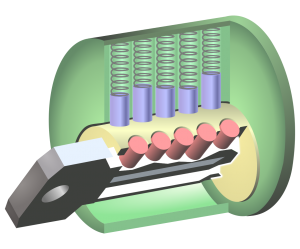 I came across this video yesterday morning and I knew I had to use it today. The internal workings of a cylindrical lock are nothing short of amazing. Check out the step by step process of how your keys are working on your house, retail/restaurant facility, or your office.
I came across this video yesterday morning and I knew I had to use it today. The internal workings of a cylindrical lock are nothing short of amazing. Check out the step by step process of how your keys are working on your house, retail/restaurant facility, or your office.
Cylindrical locks are designed so that only one key can rotate them; this rotation thus locks or unlocks the door. Inside a cylinder, there are numerous sets of pins, along a barrel. Each pin is a different height, and each set of pins rests in a cylindrical void. The void goes through the center of the barrel and into the area above it. At the top of each void are small springs which hold the pins in their respective placements. The bottom pins in each set rests completely inside the plug when no key is present, and the upper pins in each set sits partially inside the plug.
Cylindrical Locks – How they Work
The placement of the upper pin effectively secures the cylinder to the surrounding housing, preventing it from rotating. The notches on your key are made to line up with the pins just so, and when engaged will push each pin to its predetermined height. Placing the correct key into the lock will push the upper pins into the housing of the barrel. This leaves a clean line between the pins, called a “shear line.” Once the shear line is cleared, the barrel is able to rotate and releases the mechanism locking the door. Pretty cool, right?
Google

The most excellentest active gif for explaining how a pin-tumbler lock works, ever. What part is the tumbler –the plug that spins? Nothing tumbles out.
Hi, Jules! I’m unsure why the original designers decided to call them tumblers. Pin tumbler locks are locks that utilize bottom and top pins to secure the cylinder plug from turning without the proper key.